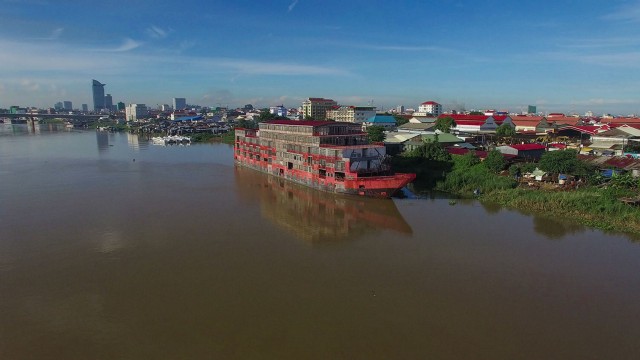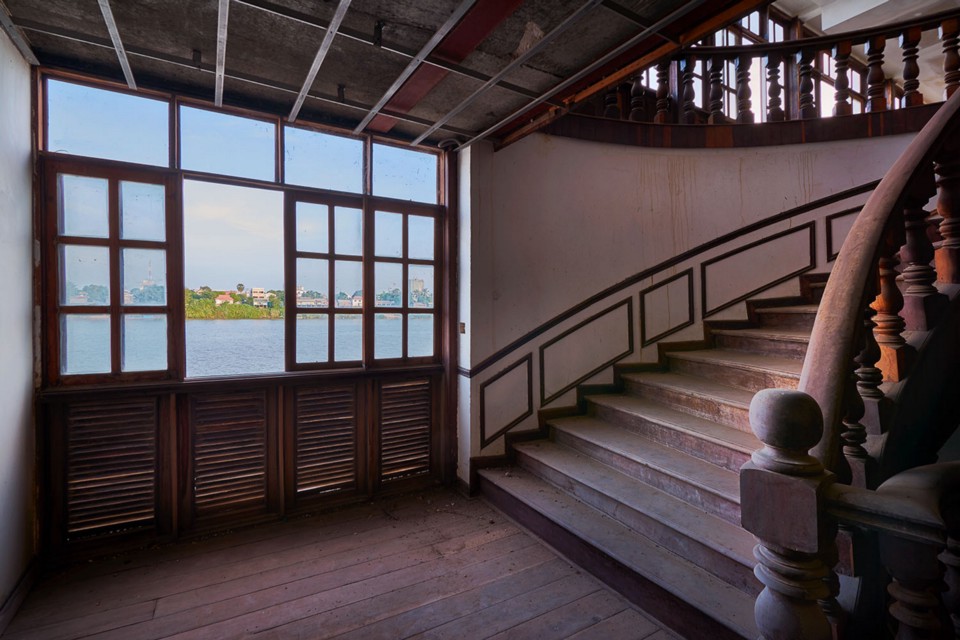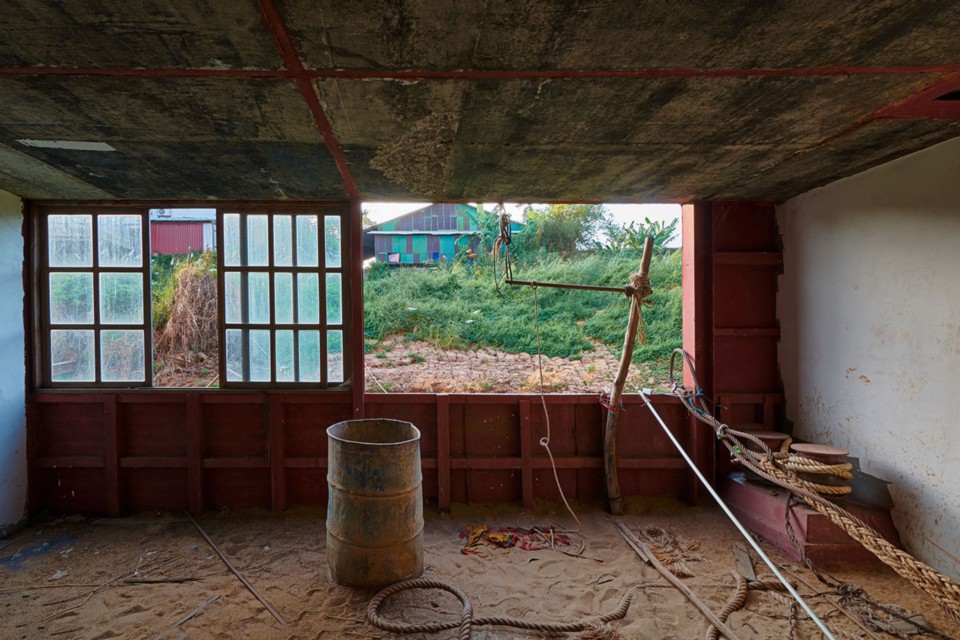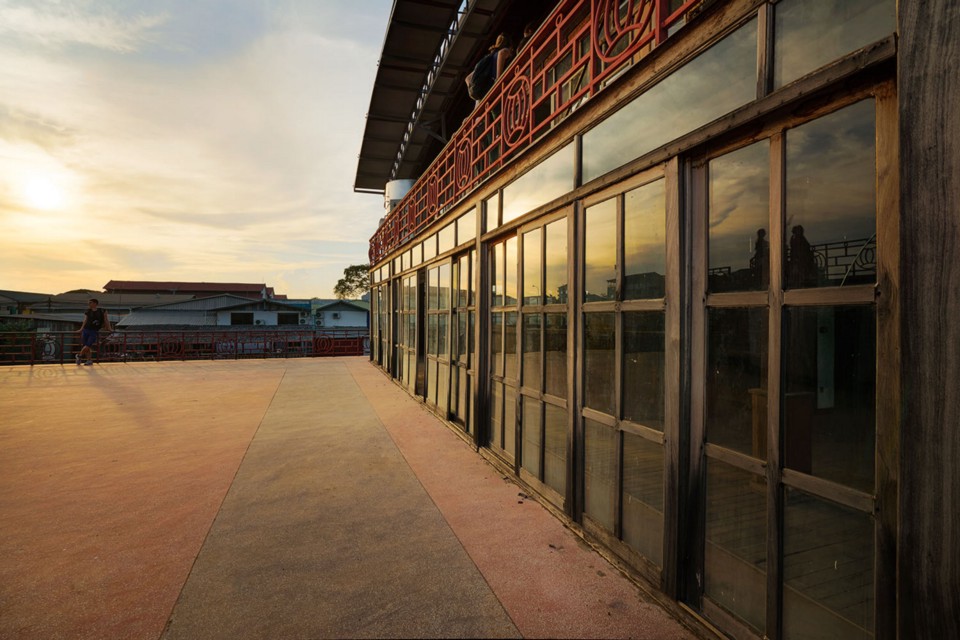An ambitious attempt to elevate Phnom Penh’s arts scene.
By Dara Bramson

(Photos: The Boat)
The Cambodian captain navigates sideways, inching closer to a 97-meter-long rust-red ship that dwarfs our open-air vessel. “That’s our entry point, get ready to jump!” yells Dana Langlois, our guide and one of the foreign locals working to turn The Boat into the future floating arts center of Phnom Penh.
Moments later, I and about two dozen passengers climb through the first-floor window one-by-one and find ourselves in a dim, dusty room littered with piles of bricks and pipes. Single-file, we tiptoe over a mound of sand and through a dark hallway lined with rubble to arrive in a sun-soaked room — filled only with snaking ropes on the floor — that will soon be a research library.
The arts are an integral part of the fabric of the capital, but, most days, art isn’t a major priority for those scraping by in one of the world’s poorest countries.
From 2010 to 2014, this vessel was planned as a 100-room floating hotel, but then sat idle and unfinished on the banks of the Tonlé Sap River. When the French-Cambodian hotel investor’s money ran out, so did the laborers: Scattered tools are abandoned on a workbench; a camouflage hammock is still secured to the bow. We follow Langlois around each of the six floors, peering into empty art studios that still look like the hotel suites they’d been designed as — some eerily outfitted with engraved wooden bed frames covered in plastic — and future exhibition areas where a dozen brand-new air conditioners still await installation. It’s no coincidence that a local hotelier, French native Alexis De Suremain, re-imagined the space with the aim of “supporting the arts as a means of driving tourism,” says Langlois, who owns Java Arts Café & Gallery and is one of three foreign co-founders.
We peer over the railing to the lush, green, trash-strewn shore, where young boys play volleyball besidedilapidated homes; in the distance, the hectic streets of Phnom Penh are thick with never-ending honking from cars, tuk-tuks, and motorcycles that weave between traffic and ride up on curbs, the drivers hollering at would-be passengers. On any given street, a random smattering of one- to five-star restaurants, bustling markets, and streetside barbers give way to independent cinemas and handcrafts boutiques. As in many developing capitals, Phnom Penh’s chichi rooftop bars look down on rickety homes and piles of garbage. Every so often, thoughtful street art or a carefully curated gallery, restaurant, or café reveals itself. It’s easy to see how The Boat — with its opportunities for young local artists and free programming — could enrich the city. The arts are an integral part of the fabric of the capital, but, most days, art isn’t a major priority for those scraping by in one of the world’s poorest countries. That’s just one reason why The Boat is so important.



(Photos: The Boat)
“We want to cultivate a local patronage for the arts,” says Langlois, who has lived in Phnom Penh since 1998. She says funding earmarked for the arts typically ends up being re-funneled into education or health budgets. “Contemporary art is quite new here, so we hope to engage the public and make sure it’s accessible.”
Their mid-year goal, depending on their fundraising, is to dock at a nearby mooring site, build an access bridge, and get The Boat’s main floor up and running. The floor plan — impressively organized for a project initiated just months ago — includes a reception area, café, art galleries, and shops, all on the main floor alone. Additional funding will allow for the construction of new levels that will include offices for rent, two restaurants, exhibition space, and an open-air stage and cinema during the dry season. The Boat would also be a base for local organizations, such as the contemporary dance and theatre company Amrita Performing Arts, which does not currently have its own office.

A version of this story first appeared in the July/August 2016 issue of Pacific Standard.
The founders plan to knock down walls to enlarge former hotel rooms into subsidized studios dedicated to artist residencies. While they aim to support artists from around the globe working on individual and collaborative projects, they intend to prioritize Cambodian visual, performing, and media artists. This is an essential aspect of the initiative in a country that continues to re-build its cultural capital in the wake of a 1975–79 genocide, during which nearly two million people — roughly 21 percent of the population — and 80 to 90 percent of the country’s artists lost their lives. Intellectuals and artists were targeted by the Khmer Rouge regime, which is why a number of local, fellow arts-centered organizations are focused on arts and healing.
Cambodian Living Arts, established in 1998, is perhaps the best-known of these. Founder Arn Chorn-Pond survived the genocide, which he attributes to his musical talent; it served as a job and emotional escape — for him, playing evoked the feeling of being “in heaven,” he told National Public Radio in 2003. After the war, he pursued community-re-building projects, and returned to Cambodia in the mid-1990s to cultivate what would become CLA. While the emphasis on arts and healing isn’t a primary focus of The Boat, Langlois says that the connection is “inevitable.”
Today, The Boat is nothing more than an impressive floating construction site. Envisioning the space as a functioning arts center requires imagination.
“At the moment it’s an idea, but it’s an idea that we’ve been able to walk through,” said United Kingdom native David Harding, a tour participant who worked with Cambodian public-health non-governmental organizations and has lived in Phnom Penh for the past 17 years. “It can create opportunities, but it has to be done very carefully to make sure it can benefit locals, and how.”


(Photos: The Boat)


(Photos: The Boat)
The founders are attuned to the project’s challenges, most notably the colonial history of Cambodia.
“We are very self-conscious that we are white people,” Langlois says. “It’s difficult in a post-colonial context with so many interventions, but I’d like to think that I have sensitivity — I live here, I’m raising my kids here, I’m not parachuting in, and I’m conscious about the local impact.”
This aspect of The Boat, in particular, is what inspired the founders to maintain a local emphasis and a model that would enable most events to be free and open to the public. As we return to port, The Boat towers over the shore, turning heads of passersby; Langlois points out the landmarks of the capital, a city where she hopes this strange floating idea might propel an artistic renaissance.

||





